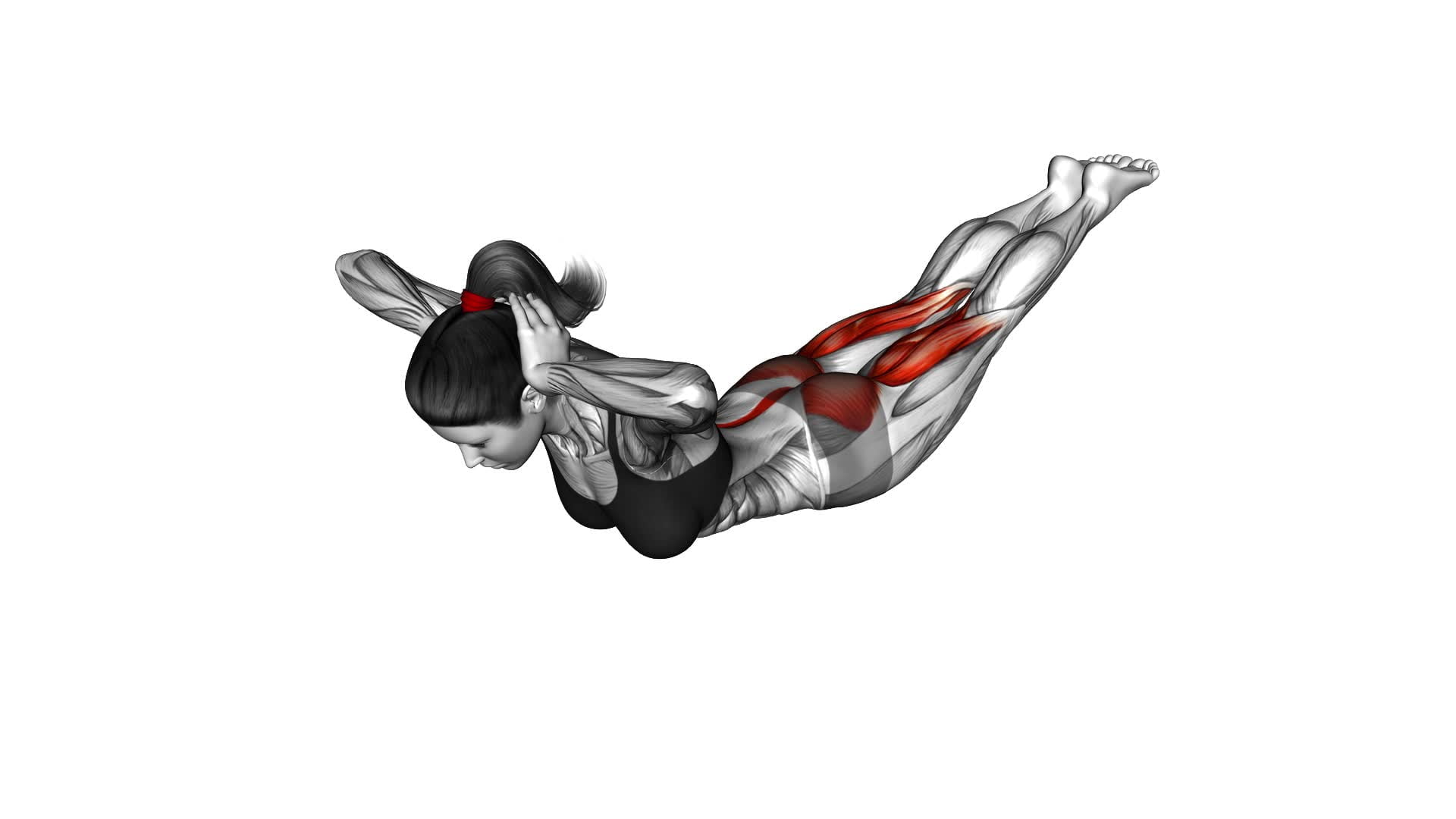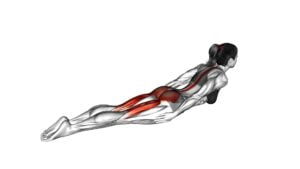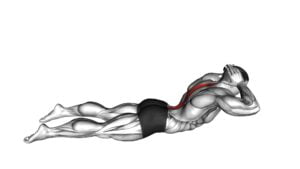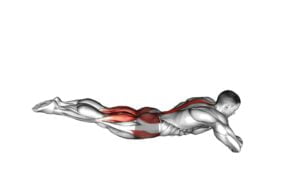Floor Hyperextension (female) – Video Exercise Guide & Tips

Are you looking to strengthen your lower back and glutes? Floor hyperextension is the perfect exercise for you.
Watch This Exercise Video
In this video exercise guide, we'll show you the proper form and technique to maximize your results. Avoid common mistakes and learn modifications for beginners.
Plus, we'll provide tips on increasing intensity and progressing in your floor hyperextension workouts.
Get ready to sculpt and tone with this effective exercise.
Key Takeaways
- Floor hyperextension strengthens and tones the lower back and glutes.
- Proper form and technique, such as maintaining pelvic alignment and engaging core muscles, are essential during floor hyperextension.
- Lower back strain can be avoided by using controlled movements and focusing on using the lower back muscles, not relying on momentum or arms.
- Modifications, progressions, and advanced variations can be implemented to increase the intensity and target specific muscles during floor hyperextension.
Benefits of Floor Hyperextension for Females
The floor hyperextension exercise offers numerous benefits for females, helping to strengthen and tone the lower back and glutes. This exercise can be modified to suit different fitness levels and abilities. By performing floor hyperextensions, you can improve your posture and overall body alignment.
One of the main benefits of floor hyperextensions is the strengthening of the lower back muscles. This can help alleviate lower back pain and improve stability in the spine. Additionally, by targeting the glutes, this exercise can enhance the shape and tone of your buttocks.
Another advantage of floor hyperextensions is the improvement in posture. By strengthening the muscles in your back and core, you can maintain a more upright position, reducing the risk of slouching and rounded shoulders. This can also contribute to a more confident and poised appearance.
To derive the maximum benefits from floor hyperextensions, it's important to perform the exercise with proper form and technique. Engage your core muscles, keep your spine neutral, and avoid any excessive arching or rounding of the back.
Proper Form and Technique for Floor Hyperextension
To perform floor hyperextensions with proper form and technique:
- Focus on maintaining pelvic alignment throughout the exercise.
- Engage your core muscles to provide stability and support for your lower back.
- Be mindful of avoiding any strain on your lower back by using controlled movements and not overextending.
Pelvic Alignment During Hyperextension
Maintain proper pelvic alignment during floor hyperextension exercises by engaging your core and focusing on your form.
Proper pelvic alignment is crucial for preventing injuries and maximizing the effectiveness of the exercise.
To ensure correct alignment, start by lying face down on the floor with your legs extended and your arms by your sides.
Engage your core muscles by pulling your belly button towards your spine.
As you lift your upper body off the floor, keep your pelvis neutral and avoid arching your lower back.
Beginners can modify the exercise by performing smaller movements and focusing on maintaining proper alignment.
Remember to listen to your body and make adjustments as needed to maintain proper form throughout the exercise.
Core Engagement for Stability
Engage your core for stability during floor hyperextension exercises. Proper core activation is essential to maintain proper form and prevent injury. Here are three key tips to help you improve your core stability during floor hyperextension:
- Brace your core: Before starting the exercise, draw your belly button towards your spine and engage your deep abdominal muscles. This will create a stable foundation and protect your lower back.
- Maintain a neutral spine: Keep your back in a neutral position throughout the movement. Avoid arching or rounding your back excessively, as this can put strain on your spine. Focus on keeping your core muscles activated and your spine in a straight line.
- Breathe and control the movement: Remember to breathe steadily throughout the exercise and maintain control over your movements. Exhale as you extend your body and inhale as you return to the starting position. This will help you maintain core stability and control the exercise.
Avoiding Lower Back Strain
Ensure proper form and technique to avoid lower back strain during floor hyperextension exercises. Preventing back injuries is crucial when strengthening the lower back.
To begin, position yourself on the floor hyperextension machine with your feet securely locked in place and your hips resting on the pad. Keep your hands interlocked behind your head or crossed over your chest.
Engage your core muscles by contracting your abs and glutes. As you lift your upper body off the pad, focus on using your lower back muscles to perform the movement. Avoid using momentum or relying solely on your arms to lift yourself up.
Maintain a slow and controlled motion throughout the exercise to prevent any strain on your lower back. By following these guidelines, you can effectively strengthen your lower back while minimizing the risk of injury.
Common Mistakes to Avoid During Floor Hyperextension
To prevent injury and maximize the effectiveness of your floor hyperextension exercise, be mindful of common mistakes that can hinder your progress. Here are three mistakes to avoid and tips for maintaining proper technique:
- Arching your back: One common mistake is arching your back excessively during the exercise. This can put unnecessary strain on your lower back and decrease the effectiveness of the movement. Instead, focus on maintaining a neutral spine throughout the exercise, keeping your back straight and aligned.
- Using momentum: Another mistake to avoid is relying on momentum to perform the exercise. This can cheat your muscles out of the work they need to do and reduce the benefits of the exercise. Instead, perform the movement in a slow and controlled manner, engaging your core and glutes to lift your legs.
- Neglecting your core: Proper engagement of your core muscles is essential for a successful floor hyperextension. Neglecting to activate your core can lead to poor form and potential injury. Before starting the exercise, engage your core by drawing your belly button towards your spine and maintaining this activation throughout the movement.
By avoiding these common mistakes and maintaining proper technique, you can ensure that you're performing the floor hyperextension exercise correctly and safely.
Now, let's move on to how to modify the floor hyperextension for beginners.
How to Modify the Floor Hyperextension for Beginners
Start with a lower range of motion, limiting the extension of your legs, to modify the floor hyperextension for beginners. By modifying exercises, you can gradually build strength and avoid injury. When performing the floor hyperextension, instead of fully extending your legs, keep them bent at a 90-degree angle. This will reduce the strain on your lower back and make the exercise more manageable for beginners.
To begin, lie face down on the floor with your legs extended behind you. Place your hands by your ears, keeping your elbows bent. Start by lifting just your upper body off the floor, focusing on engaging your lower back muscles.
As you become more comfortable and stronger, you can gradually increase the range of motion by straightening your legs further.
Remember to maintain proper form throughout the exercise. Keep your core engaged, and avoid arching your back excessively. It's important to listen to your body and progress at a pace that feels comfortable for you.
As you continue to practice and strengthen your muscles, you can gradually increase the difficulty of the floor hyperextension exercise.
Tips for Increasing Intensity and Progressing in Floor Hyperextension
To increase intensity and progress in floor hyperextension, gradually extend your legs further while maintaining proper form and engaging your core.
Here are three tips to help you increase resistance and incorporate advanced techniques into your floor hyperextension routine:
- Use ankle weights: Adding ankle weights is a simple and effective way to increase resistance during floor hyperextension. Start with a light weight and gradually increase as you become stronger.
- Incorporate resistance bands: Attach a resistance band to a stable object and loop it around your ankles. As you perform the floor hyperextension, the resistance band will add an extra challenge to your leg muscles, helping you build strength and tone.
- Try single-leg variations: Once you have mastered the regular floor hyperextension, challenge yourself by performing the exercise with one leg at a time. This will engage your muscles in a different way and increase the difficulty level.
By incorporating these tips, you can increase the intensity of your floor hyperextension routine and continue to progress towards your fitness goals.
Now, let's move on to the next section where we'll provide a sample floor hyperextension workout routine for females.
Sample Floor Hyperextension Workout Routine for Females
Now let's dive into a sample floor hyperextension workout routine specifically designed for females.
To ensure proper form, remember to engage your core, keep your back straight, and avoid overarching.
Hyperextensions offer numerous benefits, including strengthening your lower back, glutes, and hamstrings.
For advanced athletes, there are variations like weighted hyperextensions or performing the exercise on an incline bench.
Proper Form Tips
To achieve optimal results during your floor hyperextension workout routine, ensure that you maintain a proper form throughout the exercise. Here are three key tips to help you maintain proper form and maximize the benefits of your floor hyperextension workout:
- Engage your core: Before starting the exercise, activate your core muscles by pulling your belly button towards your spine. This will help stabilize your body during the hyperextension movement and protect your lower back.
- Control your movement: Slowly lower your upper body towards the floor and then lift it back up using controlled movements. Avoid any sudden or jerky motions, as this can put unnecessary strain on your back and increase the risk of injury.
- Modify as needed: If you find the standard floor hyperextension too challenging or uncomfortable, you can modify the exercise by using a smaller range of motion or adjusting the angle of your body. Listen to your body and make modifications that allow you to maintain proper form and feel the exercise in the intended muscles.
Benefits of Hyperextensions
Continue maximizing the benefits of your floor hyperextension workout routine by incorporating a sample floor hyperextension workout routine specifically designed for females.
Hyperextensions are a great exercise for improving posture and strengthening the lower back. By regularly performing hyperextensions, you can help correct muscle imbalances, reduce the risk of lower back pain, and enhance overall spinal stability.
This workout routine will target the muscles in your lower back, glutes, and hamstrings. Start by doing 2 sets of 10 repetitions, gradually increasing the number of sets and repetitions as you progress.
Remember to maintain proper form throughout the exercise, keeping your core engaged and your back straight.
Incorporating this routine into your fitness regimen will ensure that you reap the benefits of hyperextensions and achieve a strong, healthy back.
Variations for Advanced Athletes
Maximize your workout routine by incorporating advanced variations of floor hyperextensions specifically designed for female athletes. These variations will help you increase the intensity of your workouts, challenging your muscles and pushing you to new limits.
Here are three advanced variations to try:
- Weighted Hyperextensions: Hold a weight plate or dumbbell against your chest while performing the hyperextension. This added resistance will target your lower back and glutes even more, resulting in increased strength and muscle growth.
- Single-Leg Hyperextensions: Perform the hyperextensions while balancing on one leg. This variation not only increases the difficulty of the exercise but also improves your balance and stability.
- Superman Hyperextensions: Instead of keeping your arms by your sides, extend them forward as you lift your upper body off the ground. This variation engages your core muscles, including your abs and obliques, while still targeting your lower back.
Incorporating these advanced variations into your floor hyperextension routine will help you take your workouts to the next level and achieve your fitness goals.
Frequently Asked Questions
Can Floor Hyperextension Exercises Help Improve Posture in Females?
Floor hyperextension exercises can be beneficial for improving posture in females. By targeting the muscles in the back, including the erector spinae and glutes, these exercises help strengthen the core and promote proper alignment.
Incorporating floor hyperextensions into a well-rounded workout routine can contribute to overall body strength. To do this exercise, lie face down on the floor with your arms extended overhead, then lift your upper body and legs off the ground, squeezing your glutes.
Are There Any Specific Breathing Techniques to Follow During Floor Hyperextension Exercises?
During floor hyperextension exercises, it's important to focus on your breathing techniques. By inhaling deeply through your nose and exhaling through your mouth, you can engage your core muscles and improve your overall stability.
These specific breathing techniques help to maintain proper form and prevent strain on your lower back.
Additionally, floor hyperextensions provide numerous benefits for females. This includes strengthening the back muscles, improving posture, and enhancing overall body strength.
Can Floor Hyperextension Exercises Help Reduce Lower Back Pain in Females?
Floor hyperextension exercises can be beneficial in reducing lower back pain in females. By strengthening the muscles in your lower back, these exercises help provide support and stability to the spine.
The technique involves lying face down on the floor, placing your hands behind your head, and lifting your upper body off the ground while keeping your lower body stationary. Remember to engage your core and exhale as you lift, inhaling as you lower back down.
Is It Necessary to Use Equipment or Weights During Floor Hyperextension Exercises?
You don't need equipment or weights to do floor hyperextension exercises. They offer several benefits without any additional gear.
These exercises can strengthen your lower back muscles, improve posture, and increase flexibility.
To modify the exercises without weights, you can use your body weight or focus on performing the movements with controlled and proper form.
Remember to consult a professional before starting any new exercise routine.
Are There Any Alternative Exercises That Can Be Done Instead of Floor Hyperextensions for Females With Limited Mobility?
If you have limited mobility and are unable to perform floor hyperextensions, don't worry! There are alternative exercises you can do to target the same muscle groups.
Try seated back extensions or standing back extensions using a stability ball for support. These exercises can help strengthen your back and improve mobility without putting excessive strain on your body.
Remember to consult with a professional or certified trainer to ensure proper form and technique.
Conclusion
In conclusion, floor hyperextension is a beneficial exercise for females as it targets the lower back and glutes, helping to strengthen and tone these areas.
By maintaining proper form and technique, avoiding common mistakes, and modifying the exercise for beginners, females can safely and effectively perform floor hyperextensions.
By following a progressive workout routine and increasing intensity over time, females can continue to challenge their muscles and see improvements in strength and endurance.
Incorporate floor hyperextensions into your fitness routine for a stronger and more sculpted lower body.

Author
Years ago, the spark of my life’s passion ignited in my mind the moment I stepped into the local gym for the first time. The inaugural bead of perspiration, the initial endeavor, the very first surge of endorphins, and a sense of pride that washed over me post-workout marked the beginning of my deep-seated interest in strength sports, fitness, and sports nutrition. This very curiosity blossomed rapidly into a profound fascination, propelling me to earn a Master’s degree in Physical Education from the Academy of Physical Education in Krakow, followed by a Sports Manager diploma from the Jagiellonian University. My journey of growth led me to gain more specialized qualifications, such as being a certified personal trainer with a focus on sports dietetics, a lifeguard, and an instructor for wellness and corrective gymnastics. Theoretical knowledge paired seamlessly with practical experience, reinforcing my belief that the transformation of individuals under my guidance was also a reflection of my personal growth. This belief holds true even today. Each day, I strive to push the boundaries and explore new realms. These realms gently elevate me to greater heights. The unique combination of passion for my field and the continuous quest for growth fuels my drive to break new ground.







